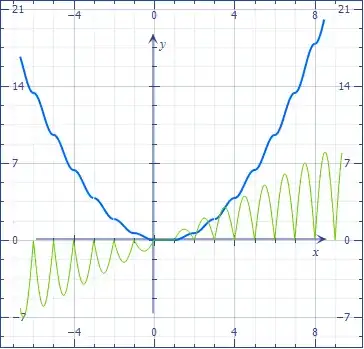On each interval $[2k,2k+1)$, because $\sin(\pi x)$ is non-negative, the integral is equal to
$$f(x) = \lfloor x\rfloor\int |\sin(\pi x)| dx = \lfloor x\rfloor\int \sin(\pi x) dx$$
Solving this integral, you get
$$f(x) = f_1(x) = -\frac{\lfloor x\rfloor}{\pi}\cos(\pi x) + A(\lfloor x\rfloor)$$
On the intervals $[2k-1, 2k)$, you will have the same result, just with a different sign,
$$f(x) = f_2(x) = \frac{\lfloor x\rfloor}{\pi}\cos(\pi x) + B(\lfloor x\rfloor)$$
Notice that the above "constants" of integration are functions of $\lfloor x\rfloor$. This is because we have integrated separately on each interval, and therefore the constants for each interval are different. To determine these constants, we will use the fact that $f(x)$ is differentiable and therefore continuous.
By continuity at the points $x=2k$, we have
\begin{eqnarray*}
&f_1(2k)=\lim\limits_{x\to2k^-} f_2(x)& \\
&\frac{2k}{\pi}\cos(2k\pi) + A(2k) = \frac{2k-1}{\pi}\cos(2k\pi) + B(2k-1)& \\
&\boxed{B(2k-1) = A(2k) + \frac{1-4k}{\pi}} \tag{1}&
\end{eqnarray*}
By continuity at the points $x=2k+1$, we have
\begin{eqnarray*}
&\lim\limits_{x\to(2k+1)^-} f_1(x) = f_2(2k+1)& \\
&-\frac{2k}{\pi}\cos(2k+1)\pi + A(2k) = \frac{2k+1}{\pi}\cos(2k+1)\pi + B(2k+1)& \\
&\boxed{A(2k) = -\frac{4k+1}{\pi} + B(2k+1)} \tag{2}&
\end{eqnarray*}
Next, since the integrand is identically zero on $[0,1)$, $f(x)=C$ is constant on this interval. Because $[0,1)$ is of the form $[2k,2k+1)$ for $k=0$, this gives us $A(0) = C$. Consequently, $(2)$ yields $B(1) = \frac{1}{\pi}+C$.
Combining $(1)$ and $(2)$ we get
\begin{eqnarray*}
&B(2k+1) = \frac{8k}{\pi} + B(2k-1) = \frac{8k}{\pi} + \frac{8(k-1)}{\pi} + B(2k-3) = \cdots =& \\
&= \frac{8}{\pi} (k+k-1+...+1) + B(1) = \frac{8}{\pi}\frac{k(k+1)}{2} + \frac{1}{\pi}+C =& \\
&= \frac{1}{\pi}(4k^2+4k+1)+C = \frac{1}{\pi}(2k+1)^2+C&
\end{eqnarray*}
Now, applying $(2)$ we get $A(2k) = \dfrac{4k^2}{\pi}+C$. A more useful way to express the last two results is
$$B(\lfloor x\rfloor) = \frac{\lfloor x\rfloor^2}{\pi}+C,\ A(\lfloor x\rfloor) = \frac{\lfloor x\rfloor^2}{\pi}+C$$
on their respective domains.
Finally, just merge the functions $f_1$ and $f_2$ into one and get
$$\boxed{\boxed{f(x) = (-1)^{\lfloor x\rfloor+1}\cdot\frac{\lfloor x\rfloor}{\pi}\cos(\pi x) + \frac{\lfloor x\rfloor^2}{\pi}+C}}$$
An easier way
First, notice that the integrand is a continuous function on $\mathbb R$. This allows us to use the Fundamental theorem of calculus, i.e.
$$f(x)=\int\lfloor x\rfloor\cdot |\sin(\pi x)| dx = \int_0^x\lfloor t\rfloor\cdot |\sin(\pi t)| dx$$
We can forget about the constant of integration for now.
Next, for $x\ge 1$, we can write
$$f(x) = \sum_{k=1}^{\lfloor x\rfloor} \int_{k-1}^k \lfloor t\rfloor\cdot |\sin(\pi t)| dt + \int_{\lfloor x\rfloor}^x\lfloor t\rfloor\cdot |\sin(\pi t)|dt$$
Use the fact that $\lfloor t \rfloor = k-1$ on the interval $[k-1,k)$, and you will get
$$\int_{k-1}^k \lfloor t\rfloor\cdot |\sin(\pi t)| dt = (k-1)\int_{k-1}^k |\sin(\pi t)| dt$$
Because $|\sin(\pi t)|$ is $1-$periodic, the integration interval $[k-1, k]$ can be reduced to the interval $[0, 1]$, which makes it easy to calculate it (the result is $2/\pi$).
Another thing you will need to use is the fact that
$$\int_{\lfloor x\rfloor}^x\lfloor t\rfloor\cdot |\sin(\pi t)|dt = \lfloor x\rfloor \int_{\lfloor x\rfloor}^x |\sin(\pi t)|dt = \lfloor x\rfloor \int_0^{x-\lfloor x\rfloor} \sin(\pi t)dt$$
For $x<1$, it can be shown that the result is the same. Also, you can add a constant of integration if you like.
